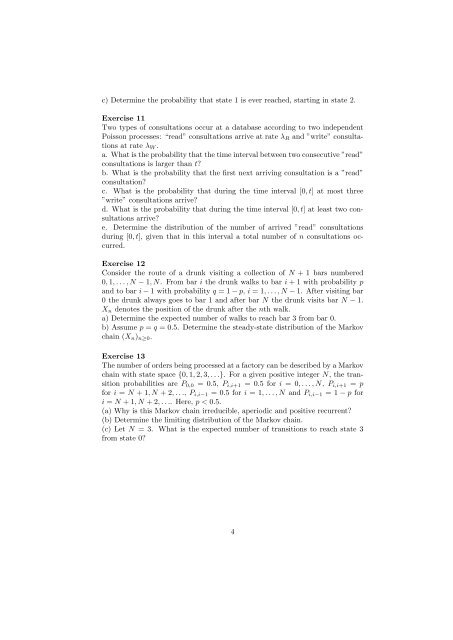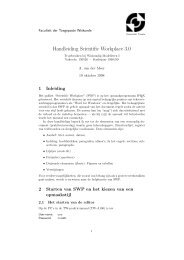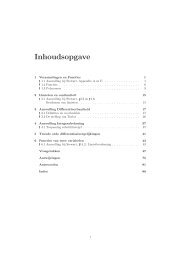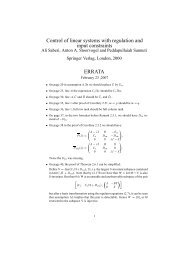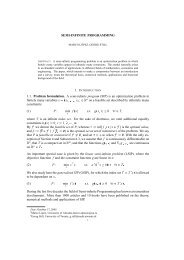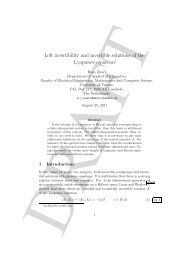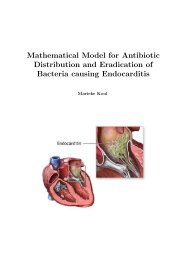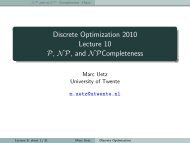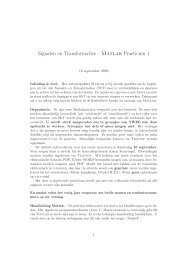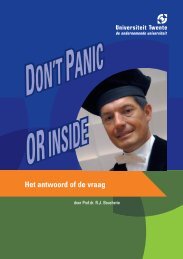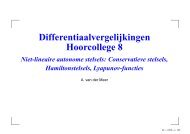Exercises Introduction to Stochastic Processes, week 1
Exercises Introduction to Stochastic Processes, week 1
Exercises Introduction to Stochastic Processes, week 1
Create successful ePaper yourself
Turn your PDF publications into a flip-book with our unique Google optimized e-Paper software.
c) Determine the probability that state 1 is ever reached, starting in state 2.<br />
Exercise 11<br />
Two types of consultations occur at a database according <strong>to</strong> two independent<br />
Poisson processes: “read” consultations arrive at rate λ R and ”write” consultations<br />
at rate λ W .<br />
a. What is the probability that the time interval between two consecutive ”read”<br />
consultations is larger than t?<br />
b. What is the probability that the first next arriving consultation is a ”read”<br />
consultation?<br />
c. What is the probability that during the time interval [0, t] at most three<br />
”write” consultations arrive?<br />
d. What is the probability that during the time interval [0, t] at least two consultations<br />
arrive?<br />
e. Determine the distribution of the number of arrived ”read” consultations<br />
during [0, t], given that in this interval a <strong>to</strong>tal number of n consultations occurred.<br />
Exercise 12<br />
Consider the route of a drunk visiting a collection of N + 1 bars numbered<br />
0, 1, . . . , N − 1, N. From bar i the drunk walks <strong>to</strong> bar i + 1 with probability p<br />
and <strong>to</strong> bar i − 1 with probability q = 1 − p, i = 1, . . . , N − 1. After visiting bar<br />
0 the drunk always goes <strong>to</strong> bar 1 and after bar N the drunk visits bar N − 1.<br />
X n denotes the position of the drunk after the nth walk.<br />
a) Determine the expected number of walks <strong>to</strong> reach bar 3 from bar 0.<br />
b) Assume p = q = 0.5. Determine the steady-state distribution of the Markov<br />
chain (X n ) n≥0 .<br />
Exercise 13<br />
The number of orders being processed at a fac<strong>to</strong>ry can be described by a Markov<br />
chain with state space {0, 1, 2, 3, . . .}. For a given positive integer N, the transition<br />
probabilities are P 0,0 = 0.5, P i,i+1 = 0.5 for i = 0, . . . , N, P i,i+1 = p<br />
for i = N + 1, N + 2, . . ., P i,i−1 = 0.5 for i = 1, . . . , N and P i,i−1 = 1 − p for<br />
i = N + 1, N + 2, . . .. Here, p < 0.5.<br />
(a) Why is this Markov chain irreducible, aperiodic and positive recurrent?<br />
(b) Determine the limiting distribution of the Markov chain.<br />
(c) Let N = 3. What is the expected number of transitions <strong>to</strong> reach state 3<br />
from state 0?<br />
4


